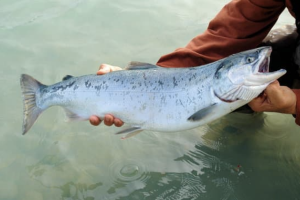
Source: OPB

Source: OPB
Extremely dry conditions have fueled a widespread die-off of fall chinook salmon on Oregon’s north coast.
After two months of low rainfall, hundreds of adult fish on multiple coastal streams are dying from an unusual outbreak of a naturally occurring parasite before they get a chance to spawn.
According to the Oregon Department of Fish and Wildlife, extended low-water conditions have led to groups of salmon waiting to swim upstream in conditions that are conducive to the cryptobia parasite. The parasite doesn’t pose a risk to humans and only affects certain species of fish.
In response to reports from the public of dead pre-spawned fall chinook salmon in the Wilson River near Tillamook, the agency surveyed the stream and discovered at least 200 dead fish.
To protect the remaining salmon, the agency closed the Wilson River to fishing earlier this month. Then the agency surveyed the Nehalem, Trask and Kilchis rivers and found similar numbers of dead salmon.
The agency has now closed all fishing for fall chinook on the North Coast from the Nestucca to Necanicum rivers, including bays. Steelhead fishing seasons are not affected.
Robert Bradley, a district biologist for ODFW, said the parasite has killed far more fish this year than it ever has before, and it’s cutting down an already depleted run of fall chinook.
“The observed pre-spawn mortality is on top of a reduced run of fall chinook this year,” Bradley said. “We need to protect the remaining spawners to help provide for future runs of fall chinook on the North Coast.”
National Weather Service hydrologist Andy Bryant says some river flows on the north coast have dropped to just 10% of normal in the past two months.
On the Wilson River, where the parasite outbreak was first detected, river flows would normally be around 2,000 cubic feet per second (cfs), but recently they’ve fluctuated between 200 and 400 cfs. The numbers are equally dismal on the nearby Nehalem River, which is normally flowing at 1,500 and 2,000 cubic feet of water per second this time of year. It’s now flowing at 150 to 300 cfs.
“Normally for the north Oregon Coast Range we’d be seeing quite a bit of rain and we just haven’t seen that,” Bryant said. “So the river has pretty much just stayed at the low flows we had seen earlier in the fall. With the lack of rainfall it hasn’t started to come up like it typically would.”
Bryant said conditions are abnormally dry across most of the state of Oregon and across the entire Pacific Northwest.
ecoShuttle’s mission is to provide innovative and flexible transportation options that harness alternative fuels and create a more sustainable Portland. Our goal is to improve the quality of life, now and for future generations, by committing to sustainable practices in everything we do. Each customer will be treated uniquely but with equal respect, and will be given the best possible experience focused on safety, reliability, and unparalleled customer service. Book a shuttle with us today!